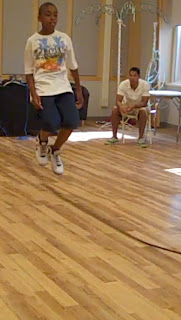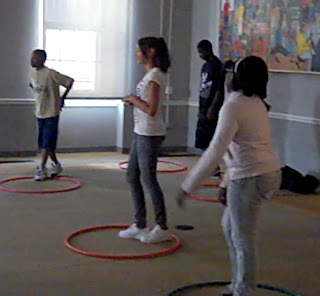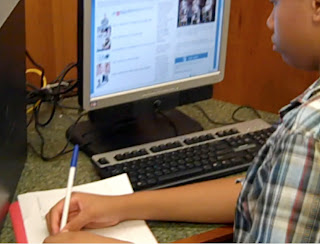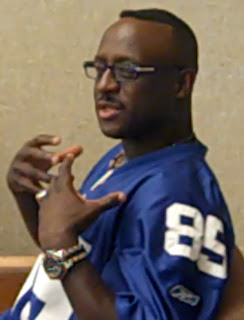Yesterday was the last day of the Newark Write on Sports camp.
Students' work was published in a magazine format.
Sample stories include:
Cheerleaders: Made to Fly, Jump, Kick, and Stunt
Is NASCAR a Sport?
600: Hall of Fame or Hall of Shame?
The Life of a Professional Football Player
Is Michael Jordan Really the Greatest Player to Ever Live?
Chris Broussard Speaks On Education
Strength, Flexibility, and Dedication = Great Gymnast
So You Think You Can Play Soccer?
Students also finished up their video projects. Some hosted their own shows about topics they like.
In this case, skateboarding.
Here specific moves are recreated with a mini-skateboard setup.
Students also co-hosted shows
played themselves
or asked staff (and other students) to play roles.
This kind of role-playing takes place because the students want to create videos that look as much as possible as what would be shown on television.
Some of the camera work was shaky, some of the editing was a bit rough, but students generally had a sense of how they wanted to shape their stories. They had introductions, multiple perspectives, and conclusions. You can tell that their sense of structure was ahead of their technical ability to pull it off, which is fine. The staff felt that with just a little more time the videos would have been stronger. This is something to keep in mind for next year. We packed a lot of work into two weeks - drafts of multiple spot stories, one final draft of a spot story, a feature story, and a video.
Time to catch our breath and reflect on the summer.
WOS was founded by Byron Yake, a former sports writer in Pittsburgh for the Associated Press and later Sports Editor of the AP. Inspiration for the project arose from Yake’s interest in journalism, sports writing and education and his desire to help students improve their writing skills. During the summer, Write on Sports runs two-week camps. During the school year, Write on Sports runs afterschool programs and holds special press-conferences. As part of their work, students interview athletes and journalists, observe and write about a minor league baseball game, and write their own stories for print and video production. The camp covers all kinds of sports - from baseball, basketball, hockey and football to soccer, fencing, swimming, curling and any other sport the students might be interested in.
Saturday, August 7, 2010
Wednesday, August 4, 2010
Newark Day Eight - Feature and Video
With the spot story out of the way, today was spent working on the print feature and video project.
The morning started with another jump rope challenge.
With the jump rope going, the students were asked to see how many they could get jumping at the same time.
They made it to four. I think the teachers only made it to two.
Students spent about an hour working on their print feature, trying to get all the background research done so that they could move into writing their first draft. They then worked on their video for the rest of the morning.
The lunchtime physical activity was a game called "Peek-a-who."
Students line up in teams on either side of a cloth
and as the cloth is dropped, whoever says the name of the student on the other side wins the point.
The game was a real hit with the students.
The afternoon was spent with more work on the feature. The plan is to finish them tomorrow, since we have to print them in form of a magazine. The students did a great job today and they know they are in the stretch run. Only two more days.
The morning started with another jump rope challenge.
With the jump rope going, the students were asked to see how many they could get jumping at the same time.
They made it to four. I think the teachers only made it to two.
Students spent about an hour working on their print feature, trying to get all the background research done so that they could move into writing their first draft. They then worked on their video for the rest of the morning.
The lunchtime physical activity was a game called "Peek-a-who."
Students line up in teams on either side of a cloth
and as the cloth is dropped, whoever says the name of the student on the other side wins the point.
The game was a real hit with the students.
The afternoon was spent with more work on the feature. The plan is to finish them tomorrow, since we have to print them in form of a magazine. The students did a great job today and they know they are in the stretch run. Only two more days.
Tuesday, August 3, 2010
Newark Day Seven - Working Away
No guests - just students and teachers getting down to work. The students did a great job of staying focused today. They finished their spot stories, with continuing support from teachers.
After completing the spot stories, they got to work on their feature stories.
Here a student is reading up on volleyball.
This student is using a graphic organizer for her feature story. It provides an outline of the issues the story will focus on (and what questions they will answer), a headline, a lead, options for how to structure the piece, and a conclusion.
Students also worked on their video projects.
The competitive cooking video is taking shape.
Physical activity today included a group jump rope activity. Students had to dash under without getting hit by the rope. Fun was had by all.
After completing the spot stories, they got to work on their feature stories.
Here a student is reading up on volleyball.
This student is using a graphic organizer for her feature story. It provides an outline of the issues the story will focus on (and what questions they will answer), a headline, a lead, options for how to structure the piece, and a conclusion.
Students also worked on their video projects.
The competitive cooking video is taking shape.
Physical activity today included a group jump rope activity. Students had to dash under without getting hit by the rope. Fun was had by all.
Monday, August 2, 2010
Newark Day Six - Revising for Language (Among other work)
The second Monday is always hard. Students are coming back after the weekend, and a summer weekend at that. For a few years now, we have made sure to start the day with a physical activity to get them going. Today we decided to play Shark Attack.
For those of you who don't know this game, everybody starts off on an island (made of a hula hoop). There is one shark in the middle. When they yell "Shark Attack" everybody has to move to a different island, and anybody who is tagged by the shark also becomes a shark. Once everybody who isn't a shark is re-established on an island any free islands are removed, and the next "shark attack" happens with all the new sharks joining the first shark.
SHARK ATTACK!
After we got the students' blood going, we started working with them around revising for language. They read the day's paper, and wrote down words they liked. Once they had a working list, they shared them with other students in a "give one - get one" activity. One reason for this activity was to get students thinking about replacing over-used words.
I like the word 'bamboozled" so I'm glad it made the general list. 'Furious' is also a good replacement for 'mad.'
Students were then given some bland sentences and asked to punch them up a bit.
The teachers encouraged the students to make their writing come alive.
Students then turned to their own spot stories and worked on revising them for language. They had worked on organization on Friday, and they will do copy editing tomorrow.
In the afternoon, students continued working on their video project and their feature stories. Staff have talked to students about how to keep track of your work so that you can properly cite it and how to analyze the trustworthiness of a web site.
For those of you who don't know this game, everybody starts off on an island (made of a hula hoop). There is one shark in the middle. When they yell "Shark Attack" everybody has to move to a different island, and anybody who is tagged by the shark also becomes a shark. Once everybody who isn't a shark is re-established on an island any free islands are removed, and the next "shark attack" happens with all the new sharks joining the first shark.
SHARK ATTACK!
After we got the students' blood going, we started working with them around revising for language. They read the day's paper, and wrote down words they liked. Once they had a working list, they shared them with other students in a "give one - get one" activity. One reason for this activity was to get students thinking about replacing over-used words.
I like the word 'bamboozled" so I'm glad it made the general list. 'Furious' is also a good replacement for 'mad.'
Students were then given some bland sentences and asked to punch them up a bit.
The teachers encouraged the students to make their writing come alive.
Students then turned to their own spot stories and worked on revising them for language. They had worked on organization on Friday, and they will do copy editing tomorrow.
In the afternoon, students continued working on their video project and their feature stories. Staff have talked to students about how to keep track of your work so that you can properly cite it and how to analyze the trustworthiness of a web site.
All in all it was a productive day.
Due to our low teacher-student ratios, students who need extra work can get extended one-on-one attention.
Friday, July 30, 2010
Newark Day Five - Guests and hard work ahead
Today was the last day that we had guests scheduled to visit us. They were introduced by an alumni of two Write on Sports camps who was visiting for the day. We talked about his choices for college, for potential careers, and various sports issues (One question he posed: Is T.O. a first ballot hall of famer?)
We were joined by Bill Ard, former left guard for the New York Giants and Green Bay Packers
and Stephen Baker, former wide receiver for the New York Giants. This is the second year Stephen Baker has visited the camp.
Both players talked about how much playing for the Giants meant to them, and their love of football more generally.
As usual, students first engaged in a general question and answer session.
Students were interested in the players' careers before football, what it felt like to play, and what they have been doing since their careers ended.
After this, students moved into Locker Room mode. The wrinkle today was that students were working with the flip cameras.
Students had to manage being respectful while still getting their questions out. At one point Bill Ard looked at a student who had been sheepishly trying to catch his attention and noted, "You gotta go for it!"
Students spent the rest of the day revising their choice of spot stories, and then planning for their print and video features.
Here is a student is thinking it through
and then getting it down on paper.
One week completed, and four drafts done. The challenge next week will be revising and reworking these pieces into publishable stories. There will be times when this work will be challenging, and I'm sure there will be times when frustration is in the air, but in the end I'm sure the students will be happier with their finished products. Even when you enjoy writing, it can be hard work.
We were joined by Bill Ard, former left guard for the New York Giants and Green Bay Packers
and Stephen Baker, former wide receiver for the New York Giants. This is the second year Stephen Baker has visited the camp.
Both players talked about how much playing for the Giants meant to them, and their love of football more generally.
As usual, students first engaged in a general question and answer session.
Students were interested in the players' careers before football, what it felt like to play, and what they have been doing since their careers ended.
After this, students moved into Locker Room mode. The wrinkle today was that students were working with the flip cameras.
Students had to manage being respectful while still getting their questions out. At one point Bill Ard looked at a student who had been sheepishly trying to catch his attention and noted, "You gotta go for it!"
Students spent the rest of the day revising their choice of spot stories, and then planning for their print and video features.
Here is a student is thinking it through
and then getting it down on paper.
One week completed, and four drafts done. The challenge next week will be revising and reworking these pieces into publishable stories. There will be times when this work will be challenging, and I'm sure there will be times when frustration is in the air, but in the end I'm sure the students will be happier with their finished products. Even when you enjoy writing, it can be hard work.
Thursday, July 29, 2010
Newark Day Four - A guest and digging in on projects
Chris Broussard was a guest at the camp today. He is a Senior Writer for ESPN the Magazine, an NBA columnist for ESPN.com, and an NBA analyst for the ESPN network. This is the second year in row that Chris has visited us. Fresh off breaking the LeBron James story, Chris was able to talk about how he gets his job done when a big story is happening - many nights with next to no sleep, plenty of phone calls to his various sources, and an ability to separate his emotions from the job he has to do as a reporter.
We watched a video of Chris talking to Vince Carter, conducted a short model interview, and then turned the floor over the students. Students asked him about his decision to become a journalist, if there were stories he regretted having written (answer: no), and what the biggest story was he ever worked on (answer: the most recent series of stories about LeBron James and the Miami Heat.)
After the open question and answer period, the students went into Locker Room mode to get the quotes and answers they wanted.
Chris reiterated some of his key themes: you need to study hard, act responsibly, and keep your eyes on the larger picture. He noted that the decisions and actions that students take at this point of their lives will have lasting ramifications, and that they don't want to look back at this time and think about the opportunities that they missed or threw away.
The audience was definitely listening.
Later in the afternoon students got to work on their big projects - print features for the collection and video stories. Print began by brainstorming ideas, narrowing them down, and refining the pitch - why somebody would be interested in reading the story. Once they had a sense of their topic, students started to do background research.
Working with a graphic organizer, students first write down what they think they know about their topic, then go about confirming those assertions. In the process, the students note any misconceptions they had, new pieces of information they have gained, and what kind of questions they have now.
This student below is working on a story about cheerleading.
In the other group, students started working on their video projects. As with the print feature, they have to narrow down their ideas, this time in pairs.
These students are working on a idea about competitive cooking, which I'm looking forward to.

This student has already started to draft a storyboard that will detail each scene - what questions will be addressed, any narration, titles, music, and what images might be necessary. This story is about the fans' perspective on the rivalry between LeBron James and Kobe Bryant. Many students working on the storyboard noticed for themselves how they really need to identify what questions each part of the video is going to address.
Here a student argues for his vision.
We watched a video of Chris talking to Vince Carter, conducted a short model interview, and then turned the floor over the students. Students asked him about his decision to become a journalist, if there were stories he regretted having written (answer: no), and what the biggest story was he ever worked on (answer: the most recent series of stories about LeBron James and the Miami Heat.)
After the open question and answer period, the students went into Locker Room mode to get the quotes and answers they wanted.
Chris reiterated some of his key themes: you need to study hard, act responsibly, and keep your eyes on the larger picture. He noted that the decisions and actions that students take at this point of their lives will have lasting ramifications, and that they don't want to look back at this time and think about the opportunities that they missed or threw away.
The audience was definitely listening.
Later in the afternoon students got to work on their big projects - print features for the collection and video stories. Print began by brainstorming ideas, narrowing them down, and refining the pitch - why somebody would be interested in reading the story. Once they had a sense of their topic, students started to do background research.
Working with a graphic organizer, students first write down what they think they know about their topic, then go about confirming those assertions. In the process, the students note any misconceptions they had, new pieces of information they have gained, and what kind of questions they have now.
This student below is working on a story about cheerleading.
In the other group, students started working on their video projects. As with the print feature, they have to narrow down their ideas, this time in pairs.
These students are working on a idea about competitive cooking, which I'm looking forward to.

This student has already started to draft a storyboard that will detail each scene - what questions will be addressed, any narration, titles, music, and what images might be necessary. This story is about the fans' perspective on the rivalry between LeBron James and Kobe Bryant. Many students working on the storyboard noticed for themselves how they really need to identify what questions each part of the video is going to address.
Here a student argues for his vision.
Wednesday, July 28, 2010
Newark Day Three - Jackals Game
Today we went to see the New Jersey Jackals, as we have done for most camps. They are always kind enough to allow us to interview players and coaches before the game. The students prepped by looking over statistics and rosters for the Jackals and their opponents today (The Brockton Rox). It was sunny, hot and a bit humid when we arrive.
Today we spoke with Paul Fagan and Chris Vasami. They are both starting pitchers who joined the Jackals about two weeks ago. They were previously with the Newark Bears, a team that plays in the Atlantic League. Since they were not pitching today they had time to field questions from the students.
Paul is on the left in the white shirt, and Chris in on the right in the black shirt.
Students were interested in their daily routines, their workout habits, and what they think of the Jackals since they are new to the team. Students also asked questions about their life outside of baseball and what they think they might do when their careers are over. Hopefully that won't happen anytime soon, since both Chris and Paul are striving to make it to the major leagues.

Once the interview was over, the students got ready for the game itself. The Jackals won 4 -1 behind the pitching of Isaac Pavlik (last week's Can Am Pitcher of the Week). Two of the runs were scored on solo shots by Jacob Butler and Adam Godwin, each of which got the crowd going. Except for a few errors, it was a well played game by both sides.
Today we spoke with Paul Fagan and Chris Vasami. They are both starting pitchers who joined the Jackals about two weeks ago. They were previously with the Newark Bears, a team that plays in the Atlantic League. Since they were not pitching today they had time to field questions from the students.
Paul is on the left in the white shirt, and Chris in on the right in the black shirt.
Students were interested in their daily routines, their workout habits, and what they think of the Jackals since they are new to the team. Students also asked questions about their life outside of baseball and what they think they might do when their careers are over. Hopefully that won't happen anytime soon, since both Chris and Paul are striving to make it to the major leagues.

Once the interview was over, the students got ready for the game itself. The Jackals won 4 -1 behind the pitching of Isaac Pavlik (last week's Can Am Pitcher of the Week). Two of the runs were scored on solo shots by Jacob Butler and Adam Godwin, each of which got the crowd going. Except for a few errors, it was a well played game by both sides.
Subscribe to:
Posts (Atom)
















































